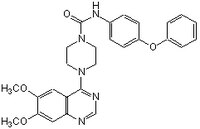521232 Sigma-AldrichPDGFR Tyrosine Kinase Inhibitor III - CAS 205254-94-0 - Calbiochem
Recommended Products
Overview
| Replacement Information |
|---|
Key Spec Table
| CAS # | Empirical Formula |
|---|---|
| 205254-94-0 | C₂₇H₂₇N₅O₄ |
| Product Information | |
|---|---|
| CAS number | 205254-94-0 |
| ATP Competitive | Y |
| Form | White solid |
| Hill Formula | C₂₇H₂₇N₅O₄ |
| Chemical formula | C₂₇H₂₇N₅O₄ |
| Reversible | Y |
| Structure formula Image | |
| Quality Level | MQ100 |
| Applications |
|---|
| Biological Information | |
|---|---|
| Primary Target | α-PDGFR |
| Primary Target IC<sub>50</sub> | 0.05 µM for α-PDGFR; 0.08 µM for β-PDGFR; 0.05 µM for c-Kit; 0.23 µM for Flt3 |
| Purity | ≥97% by HPLC |
| Physicochemical Information | |
|---|---|
| Cell permeable | Y |
| Dimensions |
|---|
| Materials Information |
|---|
| Toxicological Information |
|---|
| Safety Information according to GHS |
|---|
| Safety Information |
|---|
| Product Usage Statements |
|---|
| Packaging Information | |
|---|---|
| Packaged under inert gas | Packaged under inert gas |
| Transport Information |
|---|
| Supplemental Information |
|---|
| Specifications |
|---|
| Global Trade Item Number | |
|---|---|
| Catalogue Number | GTIN |
| 521232 | 0 |
Documentation
PDGFR Tyrosine Kinase Inhibitor III - CAS 205254-94-0 - Calbiochem SDS
| Title |
|---|
PDGFR Tyrosine Kinase Inhibitor III - CAS 205254-94-0 - Calbiochem Certificates of Analysis
| Title | Lot Number |
|---|---|
| 521232 |
References
| Reference overview |
|---|
| Matsuno, K., et al. 2003. J. Med. Chem. 46, 4910. Matsuno, K., et al. 2003. Bioorg. Med. Chem. Lett. 13, 3001. Matsuno, K., et al. 2002. J. Med. Chem. 45, 4513. Matsuno, K., et al. 2002. J. Med. Chem. 45, 3057. |







